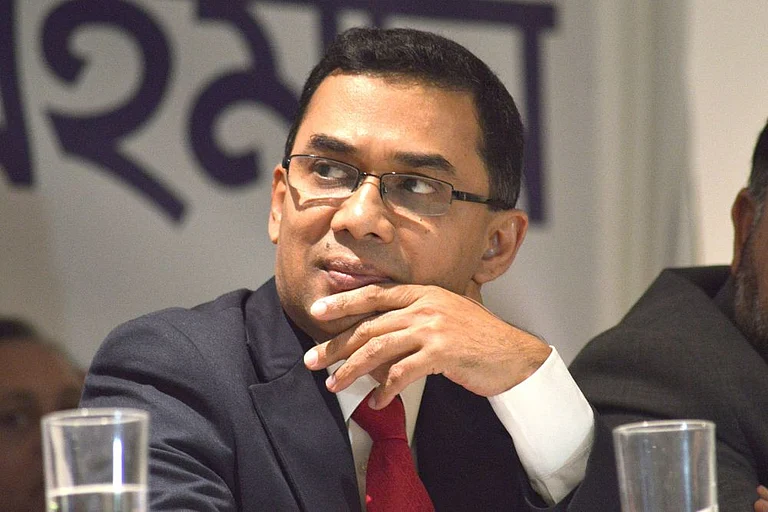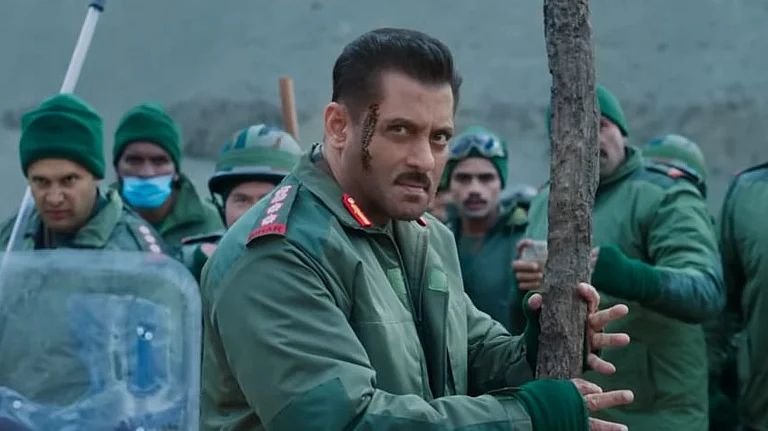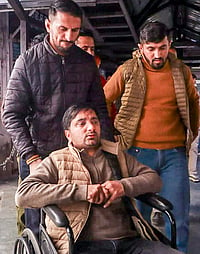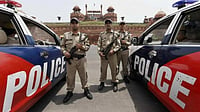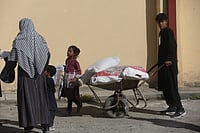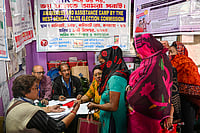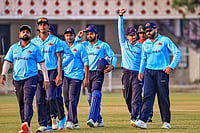...And Disillusion
- Plans to harness the Ganga from Gangotri to Uttarkashi for a series of hydroelectric projects have outraged environmentalists as well as sadhus and villagers
- 80 km of this 125-km stretch of the Ganga will be put under tunnels
- Environmentalists say it would accelerate the melting of the Gaumukh, thus drying up the river. Also, the region is quake-prone.
- Religious sentiments inflamed at bids to fetter the river flow
***
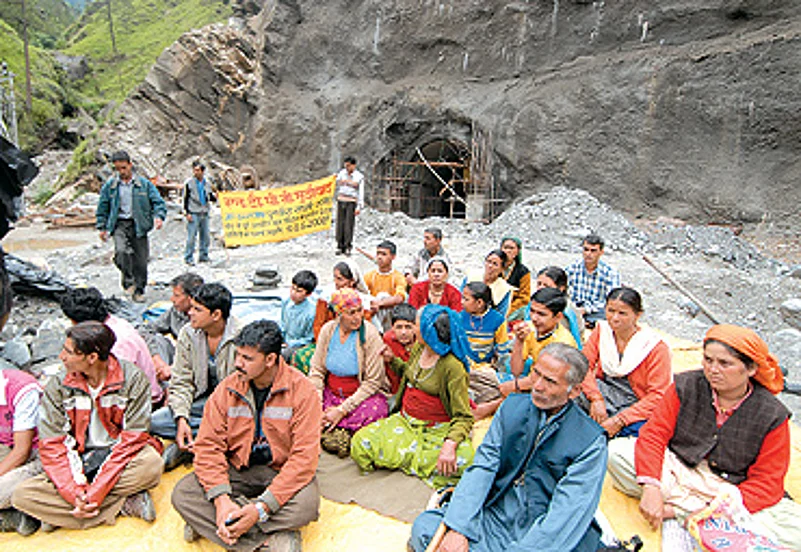
Protest at the tunnel in Loharinag Pala
Not surprisingly, therefore, the khadi-clad, snowy-bearded Agrawal's fast unto death, launched in the pilgrimage town of Uttarkashi in Uttarakhand state on June 13, to coincide with the Ganga Dussehra, has sent the government of the BJP-ruled state, the Vishwa Hindu Parishad and assorted saffron-wearing grandees into a tailspin.
The fast is in opposition to a consecutive series of hydroelectric projects—two existing, a third just inaugurated, a fourth under construction, and a fifth and sixth proposed—on the Bhagirathi, as the upper reaches of the Ganga are called, in Uttarakhand (see map). All except one, the NTPC's Loharinag Pala project, are state government projects. "What is happening is nothing less than matricide," Agrawal told Outlook emphatically at his fasting place on the Manikarnika Ghat on the banks of the Ganga. "Gangaji is being forced into one concrete tunnel after another, being sent to one powerhouse after another."
Agrawal said he was "stunned" when he visited the Bhagirathi valley last year, saw "long stretches with no water in the river bed" and realised the impact that the projects, with their multiple barrages and kilometres of sunless underground tunnels transporting river water to powerhouses, could have on the regular flow, the flora and fauna, and the purity of the river. Warns a booklet produced by his Bhagirathi Bachao Andolan: "If these projects are allowed to come up, the Ganga as we have known it will cease to exist and will be replaced by a series of reservoirs upstream of hydroelectric projects."
Fiercely articulate, despite having lived on the edge of a ghat on a diet of Gangajal for three days, Agrawal made it clear he wasn't calling for disbanding all projects on the entire 2,500-km-long river, but only on the relatively short, pristine stretch from its source in the Gaumukh glacier to Uttarkashi. "The Tehri dam was a big blunder, but I am not going into that," he says. "All I'm saying is what is upstream of Tehri must be conserved in its natural form, as a heritage for the sake of future generations. The Bhagirathi can't be treated like an ordinary river."
In reports, Agrawal and other environmentalists have raised other issues—from the implications of blasting, drilling and boring tunnels in a seismic and landslide-prone zone to the possible impact of the projects on the Gaumukh, which is already under threat due to global warming. The cooling effect of the river on the glacier will diminish, some warn, and hasten the melting of the glacier.

Agrawal, Rajendra Singh at the ghat
You have to travel the 125-km stretch from Uttarkashi to Gangotri to understand what Agrawal, Magsaysay award-winning water activist Rajendra Singh and others who have gathered at Manikarnika Ghat mean when they say the chain of hydroelectric projects will violate not just a river, but a sacred landscape. The Bhagirathi valley, with its soaring mountains, misty peaks, deodar forests, apple orchards and terraced farms, and the river, its waters currently swelled by monsoon rains and melting snow, cutting its way through dramatic narrow gorges, is a spectacularly beautiful sight. Bare-bodied sadhus with tin cans trudge along and cars packed with pilgrims rush by, all heading for the pilgrimage town of Gangotri. What spoils the picture are complaints from bewildered villagers, especially those who have recently had tunnels bored under their villages, about the drying up of water sources, cracks in houses, and the lack of proper information on the geological safety of the projects, which is a special worry in a region where memories of the 1991 Uttarkashi earthquake are still fresh.
Agrawal's argument about preserving an unfettered Bhagirathi resonates in a region where there is hardly a festival that does not involve the river. It is also an argument that has strong echoes in traditional Hindu thinking about the river and was used to block a barrage-building plan by the British way back in 1916. (In this view, the uniqueness of the river ["Gangatva"] and the self-purificatory quality of Gangajal is integrally linked to its unfettered flow.) Such religio-cultural baggage has made it obligatory for most Hindu organisations to say that they support a free-flowing Ganga. The Rashtriya Swayamsevak Sangh (RSS) routinely calls for the aviral pravah (unobstructed flow) of the river, as does the VHP, which took up cudgels against the Tehri dam on this very issue—but eventually did little to obstruct its construction. In much the same way, the saffron family has not stood in the way of Uttarakhand's escalating ambitions to transform itself into an Urja Pradesh (power state) by harnessing the hydroelectric potential of the Ganga and other mighty rivers to generate around 20,000 MW of electricity, and sell most of it to other states. Agrawal's fast is an embarrassment because it not only draws attention to the Sangh Parivar's inaction, but the role of a BJP government in allowing chhed-chhad (interference) with the river.
So, for much of this week, saffron-clad sages attached to the VHP have been travelling out of their sprawling ashrams, picturesquely situated on the banks of the Ganga, rushing between Agrawal in Uttarkashi and Uttarakhand chief minister B.C. Khanduri in Dehradun, confabulating with BJP leaders in Delhi, and making pledges at assorted baithaks and sammelans to the cause of the Ganga. As a result, Khanduri, a former general, who has for several months responded to anti-project representations with vigorous "pro-electricity" arguments (and even said in a meeting recently that Ganga-seeking pilgrims could go to Kashi rather than come to his state, as far he was concerned) has modified his stand and said he is willing to scrap two state government projects—the Pala Maneri project, which he has just inaugurated, and the Bhaironghati project, which is still only a proposal—if the Centre compensates him for the loss of electricity. As for Loharinag Pala, he told the agitators to go to Delhi to seek redressal. Suddenly in campaign mode, the VHP has also begun baying for the Centre's blood, claiming that only a BJP government at the Centre can deliver on an unfettered Bhagirathi. Clearly, the saffronites are not just defending their flanks but hijacking the issue with an eye on the general election. (According to one Sangh strategist's calculation, 48 Lok Sabha seats are in the close vicinity of the Ganga.) Sitting on the velvety lawns of his ashram in Haridwar, VHP leader Swami Chinmayananda says, "Why does Agrawal want to spare the Tehri dam, which is a central project? If we are talking about an aviral Ganga, why in this adha adhura (half-hearted) way?" Responds Rajendra Singh: "We are not out to fix the whole world. They want to give a campaign to save a small, precious part of our heritage a political thrust—turn it into another Babri Masjid or Ram Setu." "Don't play football with the Ganga, let the Ganga remain the Ganga," adds estranged RSS ideologue K. Govindacharya, who has also joined the battle for the Bhagirathi. Amid the clamour, the indomitable Agrawal fasts. The fight, he says, is far from over.








